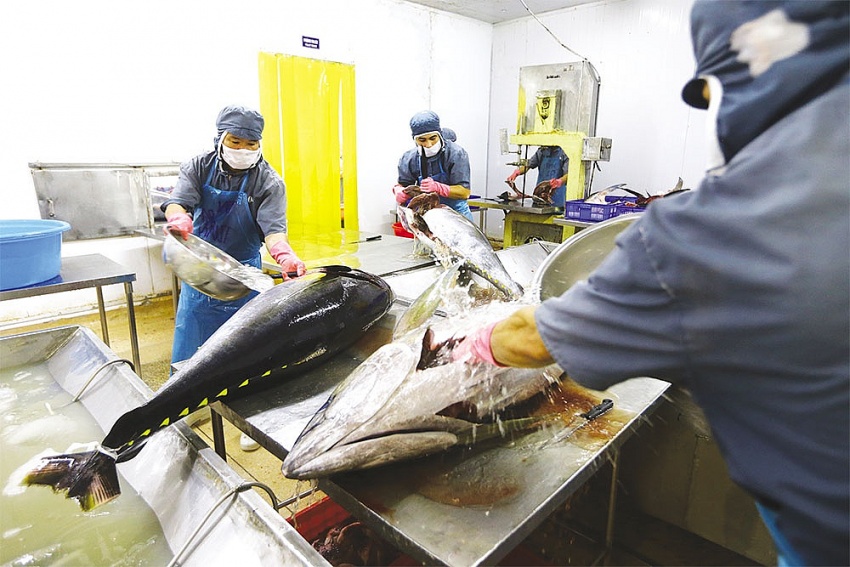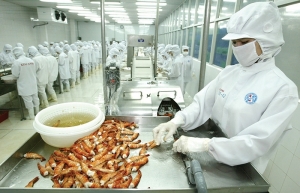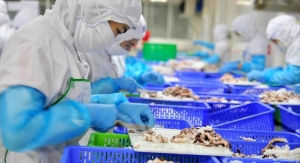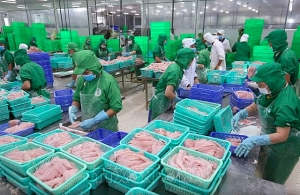Vietnam’s seafood exporters suffering with euro fluctuation
For the second time in just over a month, the euro dropped to parity with the US dollar on August 22, when the price of the former fell to a 5-week low against the latter.
On July 12, the two coins were priced at the same price for the first time in 20 years. The euro has depreciated sharply since the beginning of February when each euro was still worth $1.13. As the euro falls, so grow concerns among Vietnamese seafood exporters.
 |
| Vietnam’s seafood exporters suffering with euro fluctuation, illustration photo |
Vo Van Phuc, general director of Vietnam Clean Seafood Corporation, said, “The risk of exchange rate loss is real as businesses pay in euros and then change to VND to buy raw materials.”
However, not all seafood exporters are affected by the exchange rate. Kim Thu, an analyst at the Vietnam Association of Seafood Exporters and Producers (VASEP), said that seafood export transactions in US dollars were not affected too much.
“The impact from the exchange rate stagnates. In July, seafood exports to Europe maintained a revenue growth rate of 28 per cent and in seven months accumulated $829 million, up 39 per cent over the same period last year,” Thu said.
“But profits have dropped to low levels, possibly because buyers have reduced demand for Vietnamese seafood. Demand could also be weaker when the local currency weakens and imported goods become more expensive. Then, European consumers will consider choosing essential items at affordable prices.”
Dutch multinational Rabobank in its Global Aquaculture Update H1/2022 – which it subtitled On the Brink of Recession – predicted that the demand for seafood will decline in the second half of 2022 amid rising costs for feed, freight, and energy.
According to the report, signs of recession have already begun in both the EU and the Unied States, which are recovering from the pandemic and this would lead to reduced food demand. According to VASEP, the increase in inventories along with inflation has affected the import demand of the US since June, causing Vietnam’s seafood exports to this market to decrease by 8 per cent in that month and another, even heavier, decline of 23 per cent in July.
Accumulated in the first seven months, the export value to the US reached nearly $1.5 billion, up 31 per cent over the same period last year.
Le Hang, analyst and communications director of VASEP, commented, “The increase in inventories causes importers to limit purchases and find ways to lower import prices. The current export price cannot maintain the high level as in the first half of the year.”
According to Hang, inflation is causing people in European countries to reduce consumption. Many importers would have said that they will likely not receive orders until the end of October. Hang also confirmed that some buyers are trying to push additional storage costs onto Vietnamese enterprises.
Some businesses are heading to Japan, and the market has a high level of stability, but this country is also adjusting prices by about 20 per cent to offset inflation. Purchasing power fell sharply because Japanese consumers are very sensitive to price fluctuations.
However, Japanese buyers commonly do not cancel orders. They adjust the delivery time, delaying it 3-6 months to wait for consumers to get used to the new price.
Previously, prices were anchored at a high level with demand recovering after the peak of the pandemic, helping many large enterprises regain confidence with their profit growth plans.
For instance, Cuu Long An Giang Seafood Import-Export JSC expected pre-tax profit to increase by more than 318 per cent to $8.7 million. Other large enterprises such as Sao Ta Food JSC or Vinh Hoan JSC were also planning double-digit growth in profits. Mekong Seafood JSC also set a profit target of more than 340 per cent, even though the actual figure of around $4.35 million is low compared to other enterprises in the same industry.
Given the high-profit growth target for this year, many analysts believe that most businesses do not fully anticipate the changes in the market. Now that inflation is high and the pandemic is under control in many parts of the world, importers are not in a hurry to sign contracts like in late 2021 or early 2022. However, these factors will render seafood export difficult in the last months of the year.
 | More to come from exports in seafood Seafood exporters surprised in 2021 with a turnover of $8.9 billion, up 6 per cent compared to 2020, but experts and government officials recommend further diversifying targeted export markets and making good use of existing trade agreements. |
 | Seafood firms toast to first-quarter upbeat performance Many listed seafood producers and exporters eyed record revenue and profit figures, leveraging spikes in prices and favourable market conditions. |
 | Seafood export turnover expected to surpass $10 billion Based on the positive results in the first five months, seafood export turnover is expected to surpass $10 billion this year for the first time. |
| According to data released by the General Department of Customs, the total import-export value of the whole country in July reached $61.14 billion, down 6 per cent compared to the previous month. The Ministry of Industry and Trade estimates that exports in the fourth quarter of 2022 will shrink by 3.5 per cent while imports are expected to grow by 3.6 per cent. |
| Nguyen Hoai Nam - Deputy secretary general VASEP
This year Vietnam’s seafood industry is expected to surpass the export milestone of over $10 billion, up about 12-15 per cent on-year. However, high production costs are leading to higher product prices and the risk of reduced competitiveness. Feed for basa and shrimp accounts for 65-70 per cent of the product’s cost, but feed prices have increased by about 20 per cent since the beginning of this year. Meanwhile, the cost of transport has increased continuously. Currently, shipping one container to Europe is four times the cost of two years ago. The biggest problem with exporters is capital. Bank credit has tightened since the beginning of August, despite the fact that many importers said that they would not receive orders until October. This means that inventories increased, and businesses did not have money to pay old loans. As a result, many export businesses currently do not have money to buy fish from farmers. Le Quoc Phuong - Former deputy director Industry and Trade Information Centre, Ministry of Industry and Trade
Vietnam’s export turnover ranks 24th in the world, but the added value is lower than many countries in the region such as Singapore, Malaysia, and Thailand because agricultural products are mainly exported raw and semi-processed. In addition, the structure of export goods changed many times. Meanwhile, Vietnam’s exports are still heavily dependent on foreign-invested enterprises (FIEs). Domestic ones still have a very large trade deficit. There is a risk of falling aggregated demand due to the fear of a possible global economic recession. It is important for the state to have policies to encourage exporters to focus on quality rather than quantity. To do so, the first factor is to develop supporting industries to make good use of trade agreements. It is necessary to improve the competitiveness of enterprises to be on par with FIEs in many fields. The government also needs to step up admin reform, reduce time and financial costs, and help businesses focus on the development of human resources. Phan Thi Thanh Xuan - General secretary Vietnam Leather, Footwear, and Handbag Association
In order to compete, the industry needs to produce higher-value products, and it needs to import high-quality, high-value raw materials from other countries. Although Vietnam’s leather and footwear industry has promoted imports to markets with trade deals with Vietnam, it has not taken advantage of the opportunity to import raw materials and accessories. Especially, the EU market has a good source of high-value raw materials, suitable for manufacturing products in a higher segment. Vietnam has not yet taken advantage to import new technology and equipment in the context of sustainable production, using green and clean technology. The German government will apply the Act on Enterprise Appraisal Obligation in the supply chain from January, which will greatly affect the production chain of the Vietnamese leather and footwear industry’s goods exported to the EU market. However, most enterprises are in the dark about the implementation plan. Enterprises need to be provided with timely information. Vu Duc Giang - Chairman Vietnam Textile and Apparel Association
It was favourable in the first half of this year, but it is forecast that Vietnam’s textile and garment industry will face many challenges. Many markets that are important trade partners of Vietnam, such as China, are still applying strict anti-pandemic measures, significantly affecting the supply chain of raw materials, accessories, and consumption of textile products. High inflation in major textile-consuming markets and the Russia-Ukraine tensions caused the number of orders to drop sharply and the price of raw materials to increase continuously. For example, the price of cotton increased by 19.1 per cent and transport costs were three times higher than the average in the past five years, increasing many companies’ costs by 20-25 per cent. Although trade turnover between Vietnam and Russia and Ukraine is not large, these two countries provide basic raw materials, so a prolonged conflict will affect the price of input materials. Do Xuan Lap - Chairman Vietnam Timber and Forest Product Association
The main export markets of Vietnamese furniture, such as the United States, Europe, and the United Kingdom, are experiencing a huge drop in demand. This is having a direct impact on the production and business activities of wood enterprises as orders dropped in large volumes. A month ago, the quick survey that we conducted showed that about 71 per cent of businesses said that orders until the end of the year would continue to decrease. To help businesses overcome the current period, banks need to consider new preferential policies, such as debt rescheduling and lending rate reduction, the extension of due loans and preferential capital sources. All these will support capital for businesses to maintain production. To be more sustainable, the Ministry of Finance should also have policies on taxes to support wood businesses, such as reducing and delaying corporate income tax, reducing land rent, and refunding VAT as quickly as possible. |
What the stars mean:
★ Poor ★ ★ Promising ★★★ Good ★★★★ Very good ★★★★★ Exceptional
Related Contents
Latest News
More News
- Sustainability a core value for DKSH’s vision (January 07, 2026 | 16:00)
- People encouraged to contribute and grow at AstraZeneca Vietnam (January 07, 2026 | 15:48)
- Dat Bike accelerates sustainable mobility (January 07, 2026 | 15:24)
- Innovation to support modern healthcare development (January 07, 2026 | 10:00)
- Six localities record double-digit growth as regional performance diverges in 2025 (January 06, 2026 | 18:00)
- E-commerce market undergoes transformation amid rising competition and regulation (January 06, 2026 | 17:54)
- Vietnam’s industrial output hits seven-year high in 2025 (January 06, 2026 | 17:47)
- GELEX’s credit rating outlook upgraded to 'Positive' by VIS Rating (January 06, 2026 | 16:49)
- Finance sector lays firm groundwork for 2026 after major reform (January 06, 2026 | 15:30)
- Vietnam’s seafood exports surpass $11 billion in 2025 (January 06, 2026 | 08:51)






 Tag:
Tag:



















 Mobile Version
Mobile Version